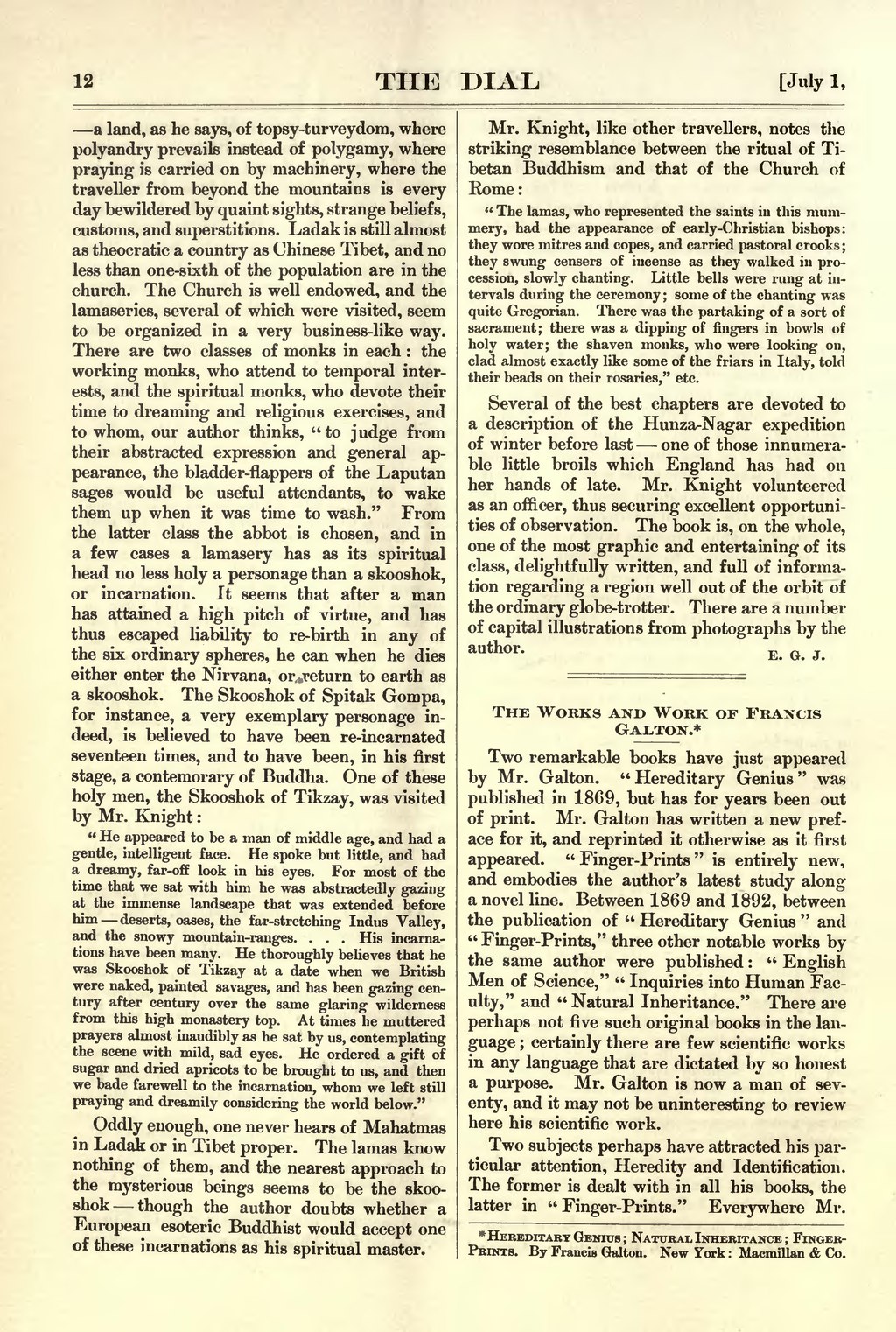—a land, as he says, of topsy-turveydom, where polyandry prevails instead of polygamy, where praying is carried on by machinery, where the traveller from beyond the mountains is every day bewildered by quaint sights, strange beliefs, customs, and superstitions. Ladak is still almost as theocratic a country as Chinese Tibet, and no less than one-sixth of the population are in the church. The Church is well endowed, and the lamaseries, several of which were visited, seem to be organized in a very business-like way. There are two classes of monks in each: the working monks, who attend to temporal interests, and the spiritual monks, who devote their time to dreaming and religious exercises, and to whom, our author thinks, "to judge from their abstracted expression and general appearance, the bladder-flappers of the Laputan sages would be useful attendants, to wake them up when it was time to wash." From the latter class the abbot is chosen, and in a few cases a lamasery has as its spiritual head no less holy a personage than a skooshok, or incarnation. It seems that after a man has attained a high pitch of virtue, and has thus escaped liability to re-birth in any of the six ordinary spheres, he can when he dies either enter the Nirvana, or return to earth as a skooshok. The Skooshok of Spitak Gompa, for instance, a very exemplary personage indeed, is believed to have been re-incarnated seventeen times, and to have been, in his first stage, a contemorary of Buddha. One of these holy men, the Skooshok of Tikzay, was visited by Mr. Knight:
"He appeared to be a man of middle age, and had a gentle, intelligent face. He spoke but little, and had a dreamy, far-off look in his eyes. For most of the time that we sat with him he was abstractedly gazing at the immense landscape that was extended before him—deserts, oases, the far-stretching Indus Valley, and the snowy mountain-ranges. . . . His incarnations have been many. He thoroughly believes that he was Skooshok of Tikzay at a date when we British were naked, painted savages, and has been gazing century after century over the same glaring wilderness from this high monastery top. At times he muttered prayers almost inaudibly as he sat by us, contemplating the scene with mild, sad eyes. He ordered a gift of sugar and dried apricots to be brought to us, and then we bade farewell to the incarnation, whom we left still praying and dreamily considering the world below."
Oddly enough, one never hears of Mahatmas in Ladak or in Tibet proper. The lamas know nothing of them, and the nearest approach to the mysterious beings seems to be the skooshok—though the author doubts whether a European esoteric Buddhist would accept one of these incarnations as his spiritual master.
Mr. Knight, like other travellers, notes the striking resemblance between the ritual of Tibetan Buddhism and that of the Church of Rome:
"The lamas, who represented the saints in this mummery, had the appearance of early-Christian bishops: they wore mitres and copes, and carried pastoral crooks; they swung censers of incense as they walked in procession, slowly chanting. Little bells were rung at intervals during the ceremony; some of the chanting was quite Gregorian. There was the partaking of a sort of sacrament; there was a dipping of fingers in bowls of holy water; the shaven monks, who were looking on, clad almost exactly like some of the friars in Italy, told their beads on their rosaries," etc.
Several of the best chapters are devoted to a description of the Hunza-Nagar expedition of winter before last one of those innumerable little broils which England has had on her hands of late. Mr. Knight volunteered as an officer, thus securing excellent opportunities of observation. The book is, on the whole, one of the most graphic and entertaining of its class, delightfully written, and full of information regarding a region well out of the orbit of the ordinary globe-trotter. There are a number of capital illustrations from photographs by the author.
The Works and Work of Francis Galton.[1]
Two remarkable books have just appeared by Mr. Galton. "Hereditary Genius" was published in 1869, but has for years been out of print. Mr. Galton has written a new preface for it, and reprinted it otherwise as it first appeared. "Finger-Prints" is entirely new, and embodies the author's latest study along a novel line. Between 1869 and 1892, between the publication of "Hereditary Genius" and "Finger-Prints," three other notable works by the same author were published: "English Men of Science," "Inquiries into Human Faculty," and "Natural Inheritance." There are perhaps not five such original books in the language; certainly there are few scientific works in any language that are dictated by so honest a purpose. Mr. Galton is now a man of seventy, and it may not be uninteresting to review here his scientific work.
Two subjects perhaps have attracted his particular attention, Heredity and Identification. The former is dealt with in all his books, the latter in "Finger-Prints." Everywhere Mr.
- ↑ Hereditary Genius; Natural Inheritance; Finger-Prints. By Francis Galton. New York: Macmillan & Co.
